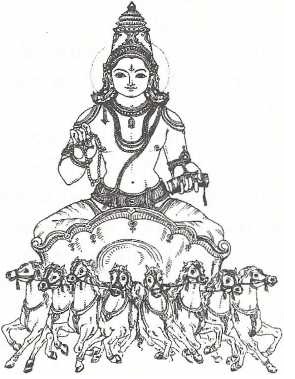Talk:Brahaspati
Bṛhaspati (‘Lord of prayer’) Bṛhaspati is a name that is often mentioned in the Hindu scriptures, right from the Rgveda up to the purāṇas and the dharmaśāstras. Obviously there are several Bṛhaspatis, divine and human. In the Rgveda he is described as the Lord of prayers and is identified with Brahmaṇaspati (2.23.1). He is considered as a devatā or a god. Gaṇapati, the later paurāṇic deity, seems to have had his origin in this Bṛhaspati-Brahmaṇaspati. During the period of the epics and the purāṇas he is described as a sage, the son of Aṅgīrasa. Being a person of great learning and wisdom and an expert in the performance of rituals, the gods in heaven under the leadership of Devendra, chose him as their guru or preceptor. Sukrācārya, the preceptor of the asuras or demons was his rival. Tārā was his wife and the mother of Budha from Candra, the moon. Budha is one of the planets.
He has many exploits attributed to him such as saving the worlds by assuming the form of Agni or fire, saving the honour of Śacīdevī, the consort of Devendra from being forced by the king Nahuṣa, surrep¬titiously acquiring the knowledge of the rejuvenation of the dead through his son Kaca, misleading the asuras when Sukrā¬cārya was away and so on. Bṛhaspati is the presiding deity of the planet called Guru or Jupiter and effects beneficial results. In the works on iconography he is described as a minor deity of splendid appearance, with rosary or with four arms, carrying a daṇḍa (staff) and a kamaṇḍalu (water-pot) in addition. He is seated on a chariot drawn by eight horses. Sometimes, Bṛhaspati is mentioned as the originator of atheism. This may have been based on the myth that he once disguised himself as Sukrācārya and taught atheism and materialism to the asuras to mislead them! There is one more Bṛhaspati, the writer of a dharmaśāstra, or arthaśāstra. Kauṭilya (300 B.C.) has quoted several verses from his work. The Mahābhārata alludes to Bṛhaspati who is said to have compressed into 3000 chapters the work on dharma, artha and kāma composed originally by Brahmā. The Vanaparva of the Mahābhārata speaks of a work called Brhaspatiniti. This Bṛhaspati is said to have advised the kings, the acquisition of only two vidyās—vartā (agriculture, trade and com¬merce) and daṇḍanīti (statecraft including the laws governing crime and punishment as also the science of war).


